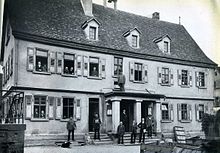Old Town Hall (Böckingen)
The old town hall on the corner of Rathausgasse and Heilbronner Straße (today: Rathausstraße / Stedinger Straße) in Böckingen , a current district of Heilbronn , was built in 1775 and used until 1926 as the seat of the municipality and later the city administration. The building was badly damaged in World War II and its ruins were demolished in 1950.
history
There has been a town hall in Böckingen since the Middle Ages. In 1544 a Böckingen town hall (new construction or renovation) was mentioned for the first time. The town hall was described again in 1651 when the council in Heilbronn allowed the Böckingen residents to remove a bell from one of the towers of the imperial city of Heilbronn and hang it in the bell tower on the roof ridge of the town hall. This town hall was shown on the plans from 1731. The old town hall on the corner of Rathausgasse and Heilbronner Straße (today Stedinger Straße) No. 4 was built in 1775 and used until 1926. Architectural details were the wooden cornice leading around the building and the portico, which was supported by three cantilever pillars at the front and three pilasters at the back. The building had a bell tower on the roof.
“ It is an elongated, two-storey building with a gable roof, on which three dormers sit facing the street and a bell tower with a small bell in the middle of the ridge. A wooden cornice leads around the house at floor level. Under a portico in the central axis of the building, supported by three cantilever pillars at the front and three pilasters at the back, the entrance is divided into two parts, and to the left of it, accessible through a special door, is the location of the police station. The house is entirely made of stone. "
The old town hall also served as a school house from 1811 until the Friedenstrasse school was built in 1878. Until 1847 there were two classrooms, then three. The hygienic conditions of the building were inadequate, so that the dean Lechler had to remark: "A very bad circumstance is that there is no toilet for the boys, so that standing around in front of the school they satisfy their natural needs."
In the period after 1878, when Böckingen's population multiplied, there was always a shortage of space in the Friedenstrasse school, so that school classes were temporarily housed again in the old town hall before the lack of space was met in 1899/1900 with the construction of the Weststrasse school . The construction of the Grünewald School in 1912/13 provided additional classrooms. When the tasks of the municipal administration increased after the town charter was granted in 1919, the old town hall became too small, while with the three existing schools there was more than enough classroom. In 1925/26, the Friedenstrasse School was therefore converted into a town hall, in which the Böckingen city administration then had its seat until it was incorporated into Heilbronn in 1933.
The old town hall was damaged in World War II and the ruins were demolished in 1950.
Since the former Friedensstrasse school was the town hall until 1933 and is still preserved today in a modified form, its building is also known as the "old town hall".
Individual evidence
- ↑ a b Helmut Schmolz , Hubert Weckbach: Heilbronn with Böckingen, Neckargartach, Sontheim. The old city in words and pictures. Vol. 1: Photos from 1860 to 1944. , Anton H. Konrad Verlag, Weißenhorn 1966, p. 56 [No. 75 Böckingen. Old Town Hall, around 1905]
- ↑ Schools in the 19th century . In: Böckingen am See , p. 414.
literature
- State Statistical Office: Description of the Oberamt Heilbronn , Kohlhammer Verlag, Stuttgart, 1903
- Peter Wanner (Red.): Böckingen am See. A district of Heilbronn - yesterday and today. Heilbronn City Archives, Heilbronn 1998, ISBN 3-928990-65-9 (Publications of the Heilbronn City Archives. Volume 37).
Coordinates: 49 ° 7 ′ 56.9 ″ N , 9 ° 11 ′ 40.4 ″ E
